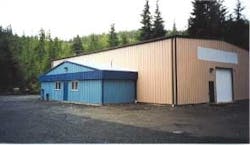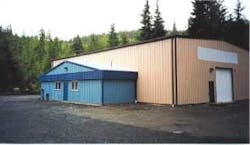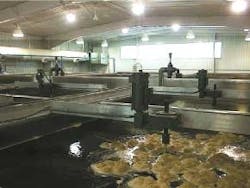Piloting to Commissioning: Design/Build of Water Treatment Plant Takes Eight Months
By Bryce McGowan
Port Hardy is a beautiful community on the North End of Vancouver Island in British Columbia, Canada. It is the home of 60 pound spring salmon; the City Manager boasts of having caught two this size in a matter of minutes. It is also the terminus of the ferry run to Northern British Columbia; Prince Rupert and the Queen Charlotte Islands.
The District of Port Hardy recently commissioned a new water treatment plant. The Tsulquate River is a highly colored water source, up to 40 true color units (TCU), and extremely low in alkalinity. The color is due to the cedar growth in the watershed. Treatment consisted of disinfection using chlorine and corrosion control using lime and carbon dioxide.
In early 1999, Port Hardy engaged EPCOR Water Services Ltd. to take over the entire water system on a design-build-operate basis, with a specific mandate to solve the water quality problem by constructing an appropriate treatment facility.
Various treatment options were evaluated including conventional and membrane technology and costs were estimated. From the evaluation, a DAF/filtration system was selected as the most appropriate and cost effective solution. The low-turbidity, tea-colored water has to be treated with a coagulant to form "floc" from the dissolved organic material and this floc tends to be fluffy and resistant to settling. Thus, the dissolved air flotation system, which is based upon myriads of microscopic bubbles buoying the floc upward, was considered to be a prime candidate.
Pacific Keystone of the Clearwater Group developed a conceptual design for the DAF/filtration plant and jointly conducted a pilot study with EPCOR. The four-week pilot study confirmed the efficacy of the process and further refined the design parameters of the full scale plant and its effectiveness was proven in the pilot testing.
With the results of the pilot study and a firm capital cost contract, EPCOR were free to proceed expeditiously; that is, they were not bound by rigid tendering procedures and similar time consuming routines. All capital cost construction items were negotiated using a "fast track" approach. Contracts were awarded for portions of the project even while others were still in the conceptual stage.
The main contract, for the treatment plant block, was let in late June 1999 as a design-build contract to Nason Contracting Group Ltd. as the General Contractor in association with Pacific Keystone as the process designer and equipment supplier.
The project benefited from the partnering approach adopted by EPCOR, the contractor and process designers with design review meetings held weekly. This hit-the-ground-running approach enabled the plant to be completed and producing treated water by late March of 2000 - less than eight months from design to commissioning.
All major tankage (DAF units and filters) were fabricated and assembled in marine grade aluminum (off-site at the Pacific Keystone manufacturing facility) and installed in Port Hardy upon a poured concrete slab. The entire plant was enclosed in a steel framed, metal clad, pre-fabricated building erected at the site. Thereafter all piping, electrical, instrumentation and building mechanical systems were installed. This use of pre-fabricated process equipment within a pre-engineered building considerably shortened the construction schedule.
The water treatment plant has a production capacity of 2.65 mgd and a hydraulic capacity of 3.3 mgd, the largest DAF drinking water plant in BC. Raw water entering the plant receives chemical addition of alum and soda ash and is then split among three DAF units. Each DAF unit incorporates flocculation (slow mixing) cells with variable speed turbine mixers followed by the flotation zone. The design surface loading on the DAF units is 4.5 US gpm/ft2.
The "float" accumulation on the surface of the DAF unit is skimmed into a trough by a traveling chain and flight scraper. It flows to a sump where it is blended with spent backwash water and pumped to the sewage system.
The Capital Cost of the New 10 ML/d Water Treatment Facility at Port Hardy was as Follows:
The combined underflow from the DAF units' clarifiers is distributed among four dual-media (anthracite and sand) filters. Filter aid polymer is added prior to filtration. Filters operate at a design filtration rate of 3.7 US gpm/ft2.
The plant (and associated systems) is highly automated with a SCADA system permitting remote operation. As is always prudent, all systems can be operated in manual mode. Each process train has full redundancy since there are three separate DAF units and four filters.
Water quality results from the new plant are excellent. Filtered water turbidity of 0.03 NTU and a colour of 2 TCU are consistently achieved. Particle counts are routinely less than 10/mL. Chlorine dosages have been reduced by approximately 80 percent, and chlorination by-products reduced by approximately 90 percent. The finished water is less aggressive and corrosive than before the plant became operational.
The unit capital cost of approximately $370,000 per ML/d is attractive by comparison to other treatment plants, especially in view the sophisticated clarification process used.
The District of Port Hardy now has a modern water treatment plant that provides safe, high quality drinking water. The plant was constructed rapidly with no increase in water rates to the consumers. The project benefited from the design-build implementation and the partnering approach that allowed for construction of the plant within 10 months from project inception. The plant's design highlights the cost-effective use of pre-fabricated plants within pre-engineered buildings.
About the Author:
Bryce McGowan, P.E., was project manager for Pacific Keystone on the Port Hardy project.



